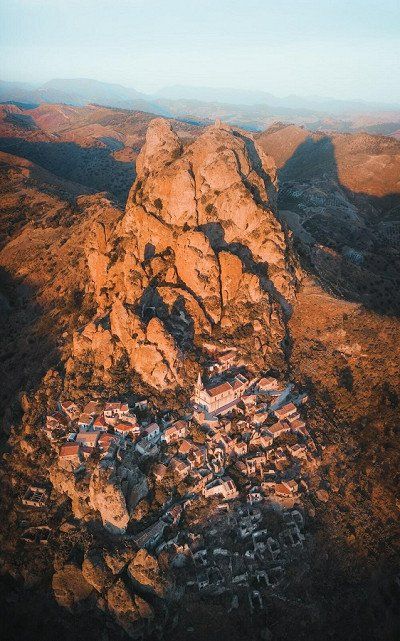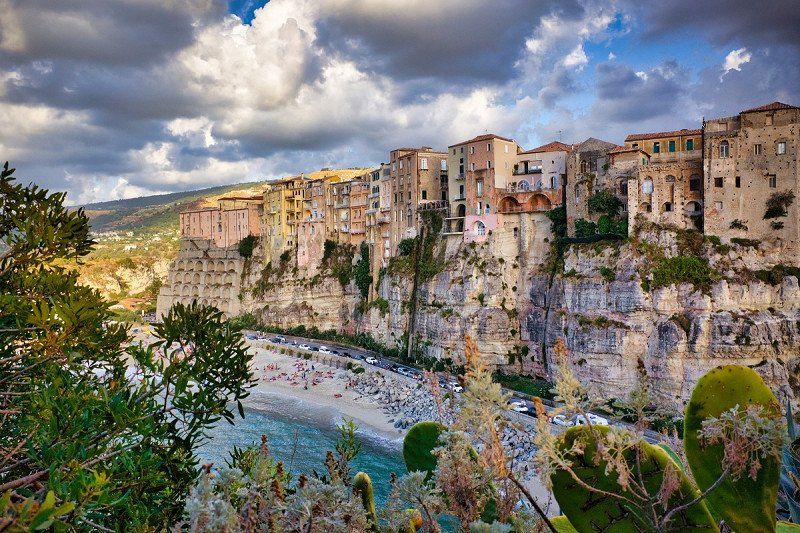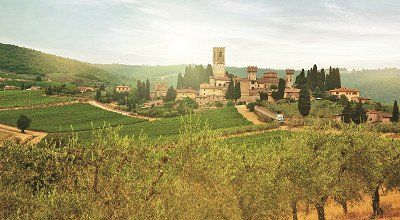The Calabria region in southern Italy is ideal for getting away from the winter blues with your motorhome or campervan. It doesn't matter whether you can escape your everyday life for just a few days or several weeks – the toe of Italy's boot welcomes sunseekers with a mild climate, lots of daylight hours, rich cuisine, towering cliffs, wild and romantic rock villages and an abundance of history and art on the Mediterranean coast. Freeontour has a few tips for a wonderful caravan or motorhome getaway to this paradise.

Where is Calabria located?
Where is Calabria located?
The metaphorical toe of Italy's boot and the southernmost region of the Italian mainland, Calabria borders on the Basilicata region to the north, the Tyrrhenian Sea to the west and the Ionian Sea to the south and east. The Calabrian coast stretches more than 780 kilometres. Its landscape features mountains joined by isthmus plains. The land is often flatter near the coast, while the interior is mainly mountainous. The Strait of Messina forms a natural border between Calabria and the nearby island of Sicily. The capital of the region is Catanzaro.
When is the best time to go camping in Calabria?
Calabria is a great place to visit at any time of the year. The hot, dry summer is the tourist peak season of the region, when thousands of holidaymakers flock to the Mediterranean for some sun, sea and sand. It is quieter and calmer in the off-season between October and May. The cool season in Calabria is comparatively mild and blessed with many hours of sunshine, with temperatures averaging around 15-20 °C even in autumn and winter. All in all, the infrastructure of the region is ideal for campervans and motorhomes due to the numerous campsites and the occasional motorhome pitch along its two coasts, some of which are open all year round and perfect for winter camping.
Click here to see campsites and motorhome pitches in Calabria in the Freeontour camping guide.

What is there to do in Calabria?
While in summer many towels and deckchairs are lined up on the beaches and finding a parking space can be challenging at times, you will have a lot of the beaches and places (practically) to yourself in the off-season between October and May. It is not uncommon to experience a decelerating effect that will encourage you to go on long walks along the beach and take part in exciting cultural activities as the vast majority of museums and excavation sites are not only open during the high season. Calabria is an important region for ancient legacies, some of which are still very well preserved.
Wild national parks await nature lovers and are perfect for hiking, rafting and mountain biking – in winter you can even go skiing on the Sila mountain range on the Ionian coast (more on that below). Furthermore, the Calabria region offers an array of beautiful rocky villages by the sea and mountain villages in the hinterland that are home to ancient palaces, castles and historical excavations, and whose beauty you can admire on a discovery tour. Nor can you go to Calabria without experiencing its culinary delights and tasty specialities.

What is there to see and do in Calabria on the Tyrrhenian coast?
Known for its turquoise sea, which stretches along two different coasts, Calabria also has an amazing hinterland worth exploring. The west coast of Calabria, i.e. the Tyrrhenian coast, is on the main transport route between northern Italy and Sicily. It is rich in picturesque towns and villages, and traversed by numerous travellers. Tourists can enjoy fantastic views of the crystal clear water as well as of the volcanic islands of Stromboli and Sicily further south, where the warm-coloured sun sets in the evening. Freeontour has put together some sights and highlights on the Tyrrhenian coast:
Tip #1: Enjoy walks along the beach and promenade at Diamante
Away from the summer crowds, you will find secluded, natural beaches in Calabria in the low-season. The bays are then often deserted and perfect for walks and picnics. A Caribbean-like eight-kilometre beach, bordered by long promenades, can be found at the coastal town of Diamante. Its Old Town is adorned with creative street art murals, while the cafés and restaurants on the promenade are ideal for making the most of the striking views of the sea while basking in the sun. Moreover, the area is famous for its chilli peppers (peperoncini) that are grown in the hinterland.

Tip #2: Admire dreamy bays, castles and palaces
Surrounded by turquoise water, the bays of Capo Vaticano are a natural gem. Hidden bays lie at the foot of imposing rock formations, watched over by fabulous old hilltop towns, which are often dominated by a castle, church or fortress, as in Tropea, Scalea, Belmonte Calabro, Amantea, Pizzo Calabro and Scilla – all wild and romantic rock towns with a wealth of charm. Tropea in particular is one of the most beautiful villages on the Tyrrhenian coast. There are two reasons for this: 1) the amazing Old Town spectacularly built on rock walls, and 2) the pilgrimage church of Santa Maria dell'Isola, sitting atop the rock and one of the most popular photo motifs in all of Calabria. If you climb the steep stairs to the church, which dates from the early Byzantine Middle Ages, you will be rewarded with a fantastic view of the Old Town of Tropea and the mountainous landscape behind it.
Tip #3: Experience culture and history in the city of Vibo Valentia
Perched on top of a hill in the hinterland, Vibo Valentia is a lively cultural city with many churches, palaces and a Norman-Hohenstaufen castle. The city bears witness to a number of former conquerors, making the region's eventful past omnipresent. Stroll through the streets and you will discover Roman mosaics, parts of the Greek city wall and Byzantine evidence or go on a guided city tour through the historic walls. Hike up to the Castello Normanno where you will enjoy a wonderful panoramic view of the landscape.

Tip #4: Appreciate nature in Pollino National Park
The coast may be stunning, but the hinterland also has a lot to offer, especially for nature lovers. Pollino National Park is the largest nature reserve in Italy, covering almost 200,000 hectares. This is where Calabria gets to show its wild side once more – waterfalls, caves, grottos, forests, ancient mountain villages and rock formations await visitors. Whether you feel like rafting, canyoning, hiking, mountain biking, canoeing, climbing or simply relaxing in nature, the park has something for everyone. One of the most famous sights of the national park is the Grotta del Romito, a cave containing remnants and murals of a prehistoric settlement.
Tip #5: Admire the Riace bronzes
Opposite Sicily is Reggio Calabria whose historic centre was destroyed by the 1908 earthquake. Housing the most important collection of Ancient Greek civilisation in Italy, the museum is also home to the famous Riace bronzes. You can also take a leisurely stroll along the promenade during a romantic sunset and take in the outstanding panoramic views of the sea and the island of Sicily beyond it.
What is there to see and do in Calabria on the Ionian coast?
The east coast of Calabria, i.e. the Ionian coast, is not as well known and more original than the west coast. Mass tourism has not arrived here yet, not even in summer, which often makes a holiday here slightly cheaper. The best time to experience the locals' way of life is during the low season when you can discover numerous archaeological excavations steeped in history. Freeontour has put together some sights and highlights on the Ionian coast in Calabria:

Tip #1: Discover the traces of ancient civilisations
The main excavations of the western Greeks and subsequently the Romans are open to the public in Locri, Monasterace and Crotone near Capo Colonna. Incidentally, Capo Colonna, which is south of Crotone, is also the easternmost point of Calabria. Many famous Olympic Games athletes came from Crotone and this is also where Pythagoras founded his school. The city of Sybaris was destroyed several times by its neighbour Crotone and finally conquered by the Romans. Its downfall and fate can still be seen today.
Tip #2: Visit the charming rock villages
Just like the Tyrrhenian coast, the Ionian coast also has many picturesque villages with quaint houses nestled on steep hilltops, often overlooked by a castle, such as in Rocca Imperiale, Oriolo, Corigliano Calabro, Santa Severina, Gerace, Stignano, Caulonia, Roccella Ionica, Palizzi and in the inland town of Castrovillari, where Byzantine and archaeological sights can still be visited today. Castles by the sea that stand out include Roseto Capo Spulico towering over a sloping cliff and Le Castella, which looks like it is floating right on the water. If you are looking for some adventure, go to Pentedattilo, an abandoned village guarded by a steep rock.

Tip #3: See a World Heritage Site in Stilo
The town of Stilo is a must-visit if you want to see examples of Byzantine architecture. The Cattolica di Stilo is one of the most important Byzantine cross-in-square churches in Italy and a UNESCO World Heritage Site. The Byzantine Orthodox Monastery of San Giovanni Theristis is nearby. And if you are not that interested in history, you can simply enjoy the wonderful tranquillity and beauty of the surrounding landscape consisting of rivers, mountains and lush green vegetation.
Tip #4: Explore the historic town of Rossano
Rossano is not only abundant in eye-catching architecture, it is also known for its rare and significant cultural heritages from the Byzantine period. This includes the Rossano Gospels, an important, illuminated manuscript of the New Testament from 550 AD, which is even listed in the UNESCO Memory of the World Register. The defiant church of Panaghia from the 11th century is also worth seeing. Moreover, the city is known for its liquorice, which you can find and taste in many shops. If you want to immerse yourself in nature after a stroll through the town, head to the WWF oasis of Cozzo del Pesco, which is not far from the city centre. It is also called the oasis of giants because of the huge chestnut trees that grow there.

Tip #5: Enjoy nature in Sila National Park
The Sila Massif is ideal for nature lovers. Its highest peak is 1,928 metres, but the national park also has other giants in the form of centuries-old trees. Rivers flow into quiet mountain lakes and you will also be able to catch sight of a wide variety of rare wild animals, such as wolves and boars. Hikers can make use of the park's extensive network of hiking trails, while outdoor enthusiasts can take a tour through the impressive Valli Cupe Canyon and be amazed by the waterfalls, botanical rarities and ancient trees. In winter, snow falls in the higher areas of the Sila Massif, making the few ski resorts here quite popular. Charming mountain villages lie scattered between the mountains, waiting to be discovered by intrepid adventurers. San Giovanni in Fiore is the oldest and most populous town in the Sila mountains and home to one of the largest abbeys in Calabria, namely the Florense Abbey.
What culinary delights can you expect in Calabria?
Calabria is also known for its delicious cuisine. You will find a wealth of sweet and savoury specialities that will tickle your palate, including N'duja, a spicy, spreadable sausage, Cipolla Rossa, sweet red onions from Tropea, which are tasty as a pasta sauce (cipollata) as well as jam (goes especially well with cheese), swordfish, tartufo ice cream from Pizzo Calabro, frisa or fresa, crunchy bread loops with a hole in the middle, chilli peppers from the Diamante area, mushrooms from the Sila mountains, liquorice from Rossano or antipasti platters with pickled vegetables and cheese specialities such as ricotta, Provolone, mozzarella or Pecorino.

Calabria also has plenty to offer wine lovers. The well-known Cirò wine is drunk with meals. Cirò refers to any white, rosé or red wine from the Calabria region with a label denoting the DOC (Denominazione di origine controllata) controlled designation of origin classification. Furthermore, the Vecchio Amaro del Capo herbal liqueur is often served after meals as a digestif. Buon appetito!




